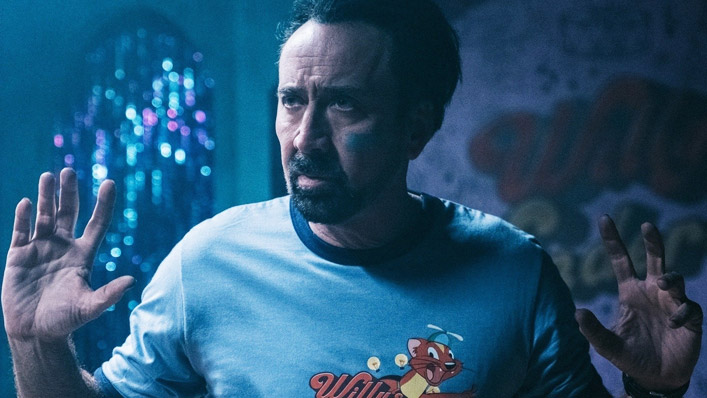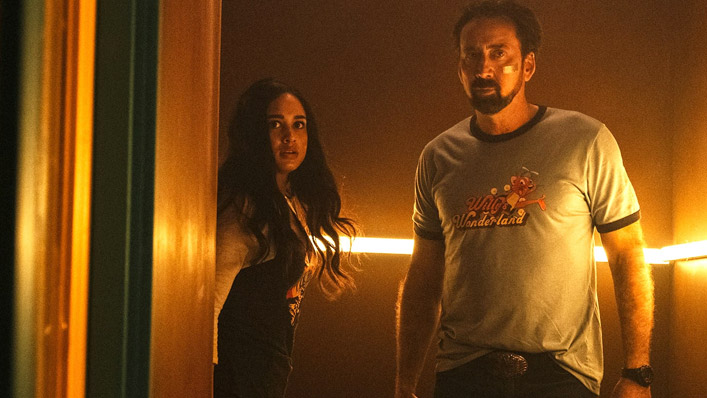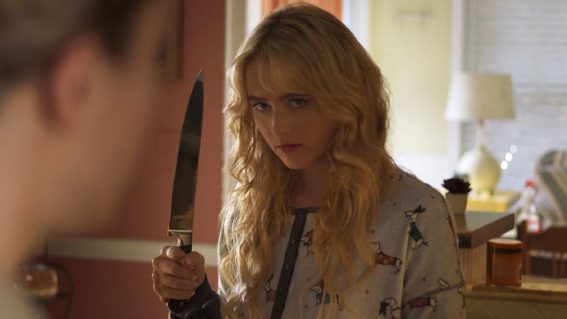Willy’s Wonderland is a weirdly entertaining experiment in the lab of Nicolas Cage

Wacky comedy-horror Willy’s Wonderland does the unthinkable, stripping Nicolas Cage of his voice. Here’s Luke Buckmaster’s review.
In an episode of the British political satire The Thick of It, a colleague of Malcolm Tucker put forward the following assessment of the legendary political operative’s work ethic: “Malcolm’s got to keep moving or he’s dead. He’s like a shark, or Bob Dylan.”
See also:
* All new streaming movies & series
* Movies now playing in cinemas
Or like Nicolas Cage. The great alchemistic actor, who is beyond prolific, has to keep moving or he’s dead, with a rapidly expanding body of work (well over 100 films and counting) to prove it. This work is among the most exciting oeuvres of any screen performer in history, not because Cage’s films are consistently good, or consistently anything, other than consistently his.

The mad scientist or—as David Lynch put it—the “jazz musician” of American acting treats his roles as laboratories with which to experiment: to toss ideas around and see what works. Most actors do this in front of a mirror; Cage does it for a living.
The low-rent comedy-horror Willy’s Wonderland—the sort of movie prefaced by the word “midnight” or the letter “B”—is the latest in Cage’s R&D workshops. It arrives with a high concept twist in that the actor, who is known for his verbal eccentricism, is given no dialogue.
Thus Cage’s character—referred to in the credits as ‘The Janitor’—joins a distinguished history of hard-bitten men who have stoically squinted and frowned through various wordless performances. The best-known point of comparison is probably Clint Eastwood’s ‘Man with No Name’, though to the best of my recollection Sergio Leone’s famous westerns did not include scenes with Eastwood dancing while playing pinball or beating up demonic animatronic animals that come alive in the dead of night.
After his car breaks down in nowheresville, Nevada, The Janitor makes a deal with a dodgy mechanic to get his wheels repaired in exchange for spending a night cleaning up an abandoned family entertainment centre. On that same night a bunch of youngsters—led by Liz (Emily Tosta)—arrive to burn the place down, knowing something he doesn’t: the animatronic characters there are possessed by the spirits of evil people, because something something, backstory backstory.
Even if he did know that, the Janitor is the kind of dude who’d accept the job anyway. Director Kevin Lewis and screenwriter G.O. Parsons push the point that nothing surprises this guy, nothing at all: not even the sight of a life size plaything named Ozzie Ostrich springing to life and proclaiming “I’m gonna feast on your face!” (This Ozzie is not to be confused with Australia’s Ossie Ostrich, Darly Somers’s co-host on the long-running variety show Hey Hey It’s Saturday. Which is a shame: I would love to see Ossie—and for that matter Daryl—flogged with two bits of wood from a broomstick snapped in half on Cage’s knee).
It’s this lack of surprise that boxes Cage’s performance in more than his character’s wordlessness, along with other absences it entails: no fear, no hesitation, no doubt. The Janitor is the solitary mythological figure who has reincarnated throughout history—the lone ranger, the samurai, the road warrior—here dancing for dimes (or during pinball sessions) in utterly dispensable entertainment. The sort of movie best experienced after a couple of bevvies and with a whooping crowd.
There’s nothing wrong with that, though films that successfully exploit the silent warrior trope tend to point outwards, away from the shapeshifting central figure. In Mad Max for instance we must examine the world and its consequences; in Leone’s Dollars Trilogy we are doused with sheer cinematic style. In Willy’s Wonderland, the audience are pushed into a less, erm, cerebral space: the space where Nicolas Cage easily defeats wacky monsters that attack him. Never in confrontations that are especially memorable or well stylized, though they are kooky enough to register some weird entertainment value.
The overarching film does have style, but as they say, style of a kind: the rough and ready grindhouse picture. Lewis draws a dehydrated look, with parched and oddly yellow grading—as if the nuances of the film’s colours have been fried out of it, the way a piece of vegetable loses its nutritional value if you throw it in a deep fryer. A thicker, gluggier scheme might have provided more atmospheric richness; instead the colours look faded, weak, drained of visage.
Which is another reason why all eyes are on Cage. I would have appreciated a more theatrical, wider-ranged performance from the great wizard, with the tension of being unable to speak translated into exaggerated gestures—like in a silent melodrama. But Cage goes the other way, bringing it in, locking his performance into a mode of ‘grim determination’, punctuated with some periodic primordial howls. His work as The Janitor is actually less physical than most of his performances. For a truly brilliant Nicolas Cage experiment the best example is still, and probably will always be, another midnight movie: the superbly deranged Vampire’s Kiss (1988).
Willy’s Wonderland has curio value as another weird potion in the strange laboratory of the Lord Cageness. But it left me wanting another wordless Cage performance. Who’s to say this experiment has run its course? The man has to keep moving, after all; maybe he’ll run into another cone of silence.


















